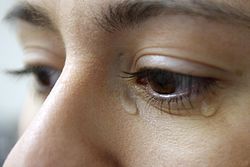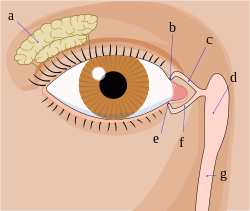
Tears are a clear liquid secreted by the lacrimal glands (tear gland) found in the eyes of all land mammals.[1] Tears are made up of water, electrolytes, proteins, lipids, and mucins that form layers on the surface of eyes.[2] The different types of tears—basal, reflex, and emotional—vary significantly in composition.[2]

- a) Lacrimal gland
- b) Superior lacrimal punctum
- c) Superior lacrimal canal
- d) Lacrimal sac
- e) Inferior lacrimal punctum
- f) Inferior lacrimal canal
- g) Nasolacrimal canal
The functions of tears include lubricating the eyes (basal tears), removing irritants (reflex tears), and also aiding the immune system.[3] Tears also occur as a part of the body's natural pain response.[4] Emotional secretion of tears may serve a biological function by excreting stress-inducing hormones built up through times of emotional distress.[5][6] Tears have symbolic significance among humans.[4]


